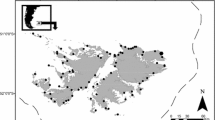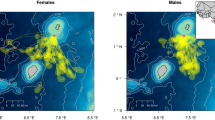Abstract
The New Zealand (NZ) sea lion (Phocarctos hookeri) is endemic to NZ and is listed as “Vulnerable” by the International Union for Conservation of Nature. Approximately 99 % of pups are born at the Auckland Islands (a declining population) and Campbell Island (a growing population). The causes of contrasting population trajectory are not well understood, though spatial and temporal variations in prey availability have frequently been implicated for other pinnipeds. This is the first published diet study of the Campbell Island population, located at the species’ southern breeding limit. Prey species were identified and quantified from scats and regurgitate samples collected in March 2013 (n = 159 and 7, respectively). An array of prey taxa was identified, though two species were particularly dominant in terms of reconstituted diet mass (M) of fishes and cephalopods: small-scaled cod (Notothenia microlepidota), which dominated scat samples (50 % M); and yellow octopus (Enteroctopus zealandicus), which dominated a small sample of regurgitates (72 % M). The diet lacked many of the key prey taxa of the Auckland Islands, and we hypothesise that the key prey identified here provides a highly available food source for the growing population of NZ sea lions at Campbell Island. These differences are likely to reflect spatial heterogeneity in prey availability and may be one of the main causes of an increase in NZ sea lion population size at Campbell Island in contrast to a decrease at the Auckland Islands.

Similar content being viewed by others
References
Anderson OF, Bagley NW, Hurst RJ, Francis MP, Clark MR, McMillan PJ (1998) Atlas of New Zealand fish and squid distributions from research bottom trawls. NIWA Technical Report, Wellington
Augé AA, Lalas C, Davis LS, Chilvers BL (2012) Autumn diet of recolonising female New Zealand sea lions based at Otago Peninsula, South Island, New Zealand. N Z J Mar Freshw Res 46:97–110
Bagley NW, Ballara S, O’Driscoll RL, Fu D, Lyon W (2013) A review of hoki and middle-depth summer trawl surveys of the Sub-Antarctic, November December 1991–1993 and 2000–2009. N Z Fisheries Assessment Report 2013/41, Ministry for Primary Industries, Wellington, New Zealand
Baker CS, Chilvers BL, Constantine R, Dufresne S, Mattlin R, Van Helden A, Hitchmough R (2010) Conservation status of New Zealand marine mammals (suborders Cetacea and Pinnipedia), 2009. N Z J Mar Freshw Res 44:101–115
Bradshaw CJA, Lalas C, McConkey S (1998) New Zealand sea lion predation on New Zealand fur seals. N Z J Mar Freshw Res 32:101–104
Cannon DY (1987) Marine fish osteology: a manual for archaeologists. Department of Archaeology, Simon Fraser University, British Columbia
Childerhouse S, Gales N (1998) Historical and modern distribution and abundance of the New Zealand sea lion Phocarctos hookeri. N Z J Zool 25:1–16
Childerhouse S, Dix B, Gayles N (2001) Diet of New Zealand sea lions (Phocarctos hookeri) at the Auckland Islands. Wildl Res 28:291–298
Childerhouse S, Hamer D, Maloney A, Michael S, Donnelly D, Schmitt N (2014) Final report: CSP project 4522 New Zealand sea lion ground component 2013/14. Blue Planet Mar, Nelson
Chilvers BL (2012) Using life-history traits of New Zealand sea lions, Auckland Islands to clarify potential causes of decline. J Zool 287:240–249
Clarke MR (1986) A handbook for the identification of cephalopod beaks. Clarendon Press, Oxford
Fernàndez DA, Lattuca ME, Boy CC, Pérez AF, Ceballos SG, Vanella FA, Morriconi ER, Malanga GF, Aureliano DR, Rimbau S, Calvo J (2009) Energy density of sub-Antarctic fishes from the Beagle Channel. Fish Physiol Biochem 35:181–188
Furlani D, Gales R, Pemberton D (2007) Otoliths of common Australian temperate fish: a photographic guide. CSIRO Publishing, Collingwood
Gauldie RW, Coote G, Mulligan KP, West IF, Merrett NR (1991) Otoliths of deep water fishes: structure, chemistry and chemically-coded life histories. Comp Biochem Physiol Part A Physiol 100:1–31
Gautier S, Fu D, O’Driscoll RL, Dunford A (2011) Acoustic estimates of southern blue whiting from the Campbell Island Rise, August–September 2009. New Zealand Fisheries Assessment Report 2011/9
Hecht T (1987) A guide to the otoliths of Southern Ocean fishes. S Afr J Antarct Res 17:1–87
IUCN (2011) IUCN red list of threatened species. Version 2011.1
Kingsford MJ, Schiel DR, Battershill CN (1989) Distribution and abundance of fish in a rocky reef environment at the subantarctic Auckland Islands, New Zealand. Polar Biol 9:179–186
Lalas C (1997) Prey of Hooker’s sea lions Phocarctos hookeri at Otago Peninsula New Zealand. In: Hindell M, Kemper C (eds) Marine mammal research in the southern hemisphere. Surrey Beatty and Sons, Chipping Norton
Lalas C, McConnell HM (2012) Prey of Auckland Island shags (Leucocarbo colensoi) in winter. Notornis 59:130–137
Lalas C, Webster T (2014) Contrast in the importance of arrow squid as prey of male New Zealand sea lions and New Zealand fur seals at The Snares, subantarctic New Zealand. Mar Biol 161:631–643
Lalas C, Ratz H, McEwan K, McConkey SD (2007) Predation by New Zealand sea lions (Phocarctos hookeri) as a threat to the viability of yellow-eyed penguins (Megadyptes antipodes) at Otago Peninsula, New Zealand. Biol Conserv 135:235–246
Lalas C, McConnell HM, Meynier L (2014) Estimating size of opalfish from otoliths: implications for analyses of New Zealand sea lions diet. N Z J Mar Freshw Res 48:1–14
Maloney A, Chilvers BL, Muller CG, Haley M (2012) Increasing pup production of New Zealand sea lions at Campbell Island/Motu Ihupuku: can it continue? N Z J Zool 39:19–29
McMahon CR, Holley D, Robinson S (1999) The diet of itinerant male Hooker’s sea lions, Phocarctos hookeri, at sub-Antarctic Macquarie Island. Wildl Res 26:839–846
Meynier L, Morel PCH, Mackenzie DDS, Macgibbon A, Chilvers BL, Duignan PJ (2008) Proximate composition, energy content, and fatty acid composition of marine species from Campbell Plateau, New Zealand. N Z J Mar Freshw Res 42:425–437
Meynier L, Mackenzie DDS, Duignan PJ, Chilvers BL, Morel PCH (2009) Variability in the diet of New Zealand sea lion (Phocarctos hookeri) at the Auckland Islands, New Zealand. Mar Mamm Sci 25:302–326
Moore PJ, Moffat RD (1992) Predation of yellow-eyed penguin by Hooker’s sea lion. Notornis 39:68–69
Moore PJ, Fletcher D, Amey J (2001) Population estimates of yellow-eyed Penguins, Megadyptes antipodes, on Campbell Island, 1987–1998. Emu 101:225–236
Morrison KW, Battley PF, Sagar PM, Thompson DR (2015) Population dynamics of Eastern Rockhopper Penguins on Campbell Island in relation to sea surface temperature 1942–2012: current warming hiatus pauses a long-term decline. Polar Biol 38:163–177
Oksanen J, Guillaume Blanchet F, Kindt R, Legendre P, Minchin PR, O’Hara RB, Simpson GL, Solymos P, Henry M, Stevens H, Wagner H (2013) Vegan: community ecology package. R package version 2.0-10. http://CRAN.R-project.org/package=vegan
O’Shea S (1999) The marine fauna of New Zealand: octopoda (Mollusca: Cephalopoda). NIWA Biodiversity Memoir 112, Wellington
Paulin CD (1983) A revision of the family Moridae (Pisces: Anacanthini) within the New Zealand region. Natl Mus N Z Rec 2:81–126
R Core Team (2014) R: a language and environment for statistical computing. R Foundation for Statistical Computing, Vienna, Austria. URL:http://www.R-project.org/
Robertson BC, Chilvers BL (2011) The population decline of the New Zealand sea lion Phocarctos hookeri: a review of possible causes. Mamm Rev 41:253–275
Robinson S, Wynen L, Goldsworthy S (1999) Predation by a Hooker’s sea lion (Phocarctos hookeri) on a small population of fur seals (Arctocephalus spp.) at Macquarie Island. Mar Mamm Sci 15:888–893
Salazar PS, Bustamante RH (2003) Effects of the 1997–1998 El Niño on population size and diet of the Galapagos sea lion (Zalophus wollebaeki). Not de Galapagos 62:40–45
Schwarzhans W (1984) Fish otoliths from the New Zealand Tertiary. Report New Zealand Geological Survey, Department of Scientific and Industrial Research, Wellington
Schwarzhans W (1999) A comparative morphological treatise of recent and fossil otoliths of the order Pleuronectiformes. Verlag F. Pfeil, München
Sinclair EH, Zeppelin TK (2002) Seasonal and spatial differences in diet in the western stock of steller sea lions (Eumetopias jubatus). J Mamm 83:973–990
Smale MJ, Watson G, Hecht T (1995) Otolith atlas of southern African fishes. Ichthyol Monogr 1:1–253
Smith RO, Vennell R, Bostock HC, Williams MJM (2013) Interaction of the Subtropical Front with topography around southern New Zealand. Deep Sea Res I 76:13–26
Taylor RH, Sadlier RM (1985) Report on work of ecology division, DSIR, during the sub-Antarctic cruise of HMNZS Monowai, 7 February-13 March 1985. Unpublished report, Ecology Division, New Zealand Department Scientific and Industrial Research, Lower Hutt
Thompson FN, Berkenbusch K, Abraham ER (2013) Marine mammal bycatch in New Zealand trawl fisheries, 1995–1996 to 2010–2011. New Zealand aquatic environment and biodiversity report. New Zealand Ministry for Primary Industry, Wellington
Tollit D, Heaslip S, Deagle B, Iverson S, Joy R, Rosen D, Trites A (2006) Estimating diet composition in sea lions: which technique to choose? Pages 293–307. In: Trites AW, Atkinson SK, DeMaster DP, Fritz LW, Gelatt TS, Rea LD, Wynne KM (eds) Sea lions of the world. Alaska Sea Grant College Program, University of Alaska Fairbanks
Trites AW, Donnelly CP (2003) The decline of Steller sea lions Eumetopias jubatus in Alaska: a review of the nutritional stress hypothesis. Mamm Rev 33:3–28
Williams R, McEldowney A (1990) A guide to the fish otoliths from waters off the Australian Antarctic Territory, Heard and Macquarie Island. ANARE Research Notes 75, Australian National Antarctic Research Expeditions, Kingston
Xavier JC, Cherel Y (2009) Cephalopod beak guide for the Southern Ocean. British Antarctic Survey, Cambridge
Acknowledgments
This research was supported by the NIWA Core Funding Program and the NZ Department of Conservation. We would like to thank Mary-Anne Lea, Mark Hindell (both University of Tasmania, Australia), Kimberley Vinette Herrin (Sydney Zoo, Australia) and Robert Mattlin (Marine Wildlife Research, NZ) for assistance with the collection of samples. Also Jeff Forman for the identification of invertebrate prey items and Darren Stevens (both NIWA, NZ) for assistance with identification from cephalopod beaks and Alan Tennyson and Colin Tinkler (both Te Papa Museum, NZ) for tentative identifications from bird feathers. All samples were collected in accordance with ethical conditions specified in the NZ Department of Conservation Research Permit Number 35879-FAU. CL thanks Sanford Ltd for permission to collect specimen fish, cephalopod and crustaceans aboard their chartered trawlers. Finally, we thank the four reviewers who provided appreciated suggestions for improving this manuscript.
Author information
Authors and Affiliations
Corresponding author
Electronic supplementary material
Below is the link to the electronic supplementary material.
Rights and permissions
About this article
Cite this article
Roberts, J., Lalas, C. Diet of New Zealand sea lions (Phocarctos hookeri) at their southern breeding limits. Polar Biol 38, 1483–1491 (2015). https://doi.org/10.1007/s00300-015-1710-3
Received:
Revised:
Accepted:
Published:
Issue Date:
DOI: https://doi.org/10.1007/s00300-015-1710-3




